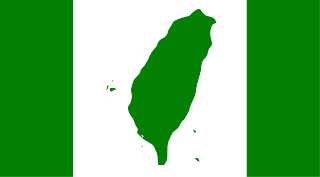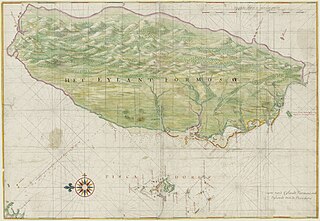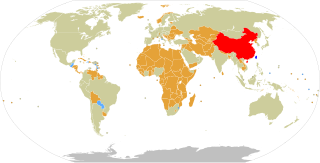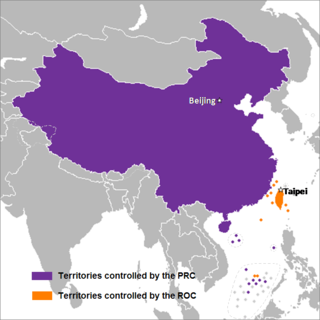
The Manchu people in Taiwan constitute a small minority of the population of Taiwan.

The Manchu people in Taiwan constitute a small minority of the population of Taiwan.
The Manchu people living in Taiwan arrived primarily in two waves of migration. The first wave was during the Qing dynasty era, in which the Manchu-led government annexed Taiwan into the Qing Empire. [1] The second wave was immediately following the Chinese Civil War, when the Kuomintang retreated to Taiwan. As of 2009 [update] , there are about 12,000 Manchu people living in Taiwan. [2]


The Taiwan independence movement is a political movement to seek formal international recognition of Taiwan as an independent, sovereign nation and in opposition to Chinese unification.

The history of the island of Taiwan dates back tens of thousands of years to the earliest known evidence of human habitation. The sudden appearance of a culture based on agriculture around 3000 BC is believed to reflect the arrival of the ancestors of today's Taiwanese indigenous peoples. The island was colonized by the Dutch in the 17th century, followed by an influx of Hoklo people including Hakka immigrants from the Fujian and Guangdong areas of mainland China, across the Taiwan Strait. The Spanish built a settlement in the north for a brief period but were driven out by the Dutch in 1642.

The National Palace Museum, located in Taipei, Taiwan, has a permanent collection of nearly 700,000 pieces of ancient Chinese imperial artifacts and artworks, making it one of the largest of its type in the world. The collection encompasses 8,000 years of history of Chinese art from the Neolithic age to the modern. Most of the collection are high quality pieces collected by China's emperors. The National Palace Museum shares its roots with the Palace Museum in the Forbidden City, whose extensive collection of artwork and artifacts were built upon the imperial collections of the Ming and Qing dynasties.

The "One-China policy" is a policy asserting that there is only one sovereign state under the name China, as opposed to the idea that there are two states, the People's Republic of China (PRC) and the Republic of China (ROC), whose official names incorporate "China". Many states follow a one China policy, but the meanings are not the same. The PRC exclusively uses the term "One China Principle" in its official communications.

Chinese nationalism is a form of nationalism in both mainland China and Taiwan which asserts that the Chinese people are a nation and promotes the cultural and national unity of all Chinese people. It is significantly distinct from Han nationalism, a sense of jingoism that is felt by purely Han Chinese people who deem themselves superior to other existing ethnicities in China.

The flag of the Republic of China (中華民國國旗), also known as the Blue Sky, White Sun, and a Wholly Red Earth (青天白日滿地紅) and retroactively, the National Flag of China consists of a red field with a blue canton bearing a white disk surrounded by twelve triangles; said symbols symbolize the sun and rays of light emanating from it, respectively.

The History of the Republic of China begins after the Qing dynasty in 1912, when the formation of the Republic of China as a constitutional republic put an end to 2,000 years of imperial rule. The Manchu-led Qing dynasty ruled China proper from 1644 to 1912. The Republic experienced many trials and tribulations after its founding which included being dominated by elements as disparate as warlord generals and foreign powers.

Taiwanese nationalism is a nationalist movement to identify the Taiwanese people as a distinct nation. Due to the complex political status of Taiwan, it is strongly linked with the Taiwan independence movement in seeking an identity separate from the Chinese. This involves the education of history, geography, and culture from a Taiwan-centric perspective, promoting native languages of Taiwan such as Taiwanese Hokkien, Hakka, and indigenous languages, as well as reforms in other aspects.
Taiwanese people are people from Taiwan who share a common culture, ancestry, and speak Taiwanese Mandarin, Hokkien, Hakka, or indigenous Taiwanese languages as a mother tongue. Taiwanese people may also refer to individuals who are ascribed cultural identity from areas under the control of the Government of Taiwan since 1945, including Penghu, Kinmen, and Matsu islands. At least three competing paradigms are used to identify someone as a Taiwanese person: nationalist criteria, self-identification criteria, and socio-cultural criteria. These standards are fluid, and result from evolving social and political issues. The complexity resulting from competing and evolving standards is compounded by a larger dispute regarding Taiwan's identity, the political status of Taiwan, and its potential de jure Taiwan independence or Cross-Strait Unification.

The term Two Chinas refers to the current geopolitical situation of two political entities each calling itself "China":
The Government of the Republic of China, also known retroactively as the Government of Nationalist China, is the unitary government that exercises control over Taiwan and other islands in the free area. The president is the head of state. The government consists of Presidency and five branches (Yuan): the Executive Yuan, Legislative Yuan, Judicial Yuan, Examination Yuan, and Control Yuan.

The Mongolian and Tibetan Affairs Commission was a ministry-level commission of the Executive Yuan in the Republic of China (Taiwan). It was disbanded on September 15, 2017.

Puru, also known as Pu Xinyu 溥心畬, Xinyu being his courtesy name, and Xishan Yishi 西山逸士, which is his sobriquet, was a traditional Chinese painter, calligrapher and nobleman. A member of the Manchu Aisin Gioro clan, the ruling house of the Qing dynasty, he was a cousin to Puyi, the last Emperor of China. It was speculated that Puru would have succeeded to the Chinese throne if Puyi and the Qing government were not overthrown after the 1911 Xinhai Revolution.

The History of the Kuomintang is an article on the inception of the Kuomintang, a Chinese political party that ruled China 1927–48 and then moved to Taiwan. The name translates as "China's National People's Party" and was historically referred to as the Chinese Nationalists. The Party was initially founded on 23 August 1912, by Sun Yat-sen but dissolved in November 1913. It reformed on October 10th 1919, again led by Sun Yat-sen, and became the ruling party in China. After Sun's death, the party was dominated from 1927 to 1975 by Chiang Kai-shek. Though the KMT lost the civil war with the Communist Party of China in 1949, the party took control of Taiwan and remains a major political party of the Republic of China based in Taiwan.

King Pu-tsung is a Taiwanese politician. He served as the Secretary-General of the National Security Council from 25 March 2014 until 12 February 2015. King was widely regarded as the most important aide to Ma Ying-jeou. He served as the Secretary-General of Kuomintang (KMT) from December 2009 to January 2011. King also served as Vice Mayor of Taipei from 2002 to 2006 and had previously been a scholar and journalist. King is alleged to be a descendant of the Aisin Gioro clan.

The Republic of China (ROC) was a sovereign state based in mainland China between 1912 and 1949, prior to the relocation of its government to the island of Taiwan. It was established on 1 January 1912 after the Xinhai Revolution, which overthrew the Qing dynasty, the last imperial dynasty of China.
Events from the year 1960 in Taiwan, Republic of China. This year is numbered Minguo 49 according to the official Republic of China calendar.

Myanmar–Taiwan relations refers to the international relations between Myanmar and the Republic of China. There are no official relations between the two countries, as Myanmar only recognizes the People's Republic of China.

Xinjiang Province or Sinkiang Province refers to a former province of the Republic of China. First set up in 1884 as a province of the Qing dynasty, it was replaced in 1955 by the Xinjiang Uygur Autonomous Region of the People's Republic of China. The original provincial government was relocated to Taipei as the Sinkiang Provincial Government Office (新疆省政府辦事處) until its dissolution in 1992.